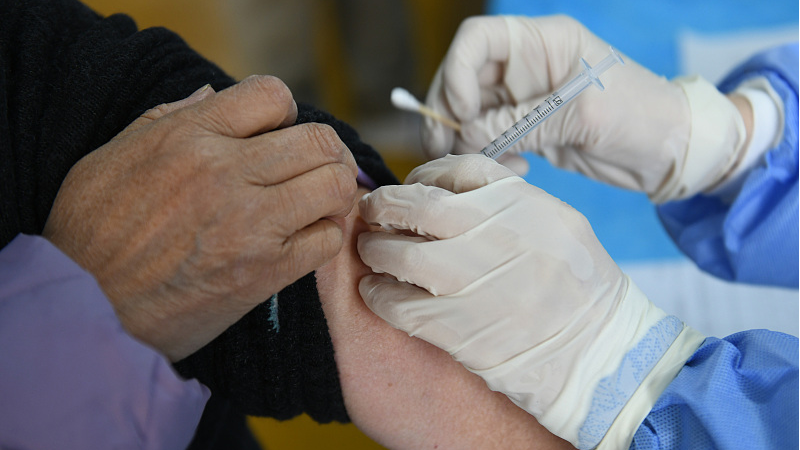
The Joint Prevention and Control Mechanism of the State Council holds a press conference in Beijing, China, December 8, 2022. /CFP
The Joint Prevention and Control Mechanism of the State Council holds a press conference in Beijing, China, December 8, 2022. /CFP
Editor's note: Anthony Moretti is an associate professor at the Department of Communication and Organizational Leadership at Robert Morris University. The article reflects the author's opinions and not necessarily those of CGTN.
The U.S. and Western media have built a narrative about China and COVID-19 since early 2020 to suggest that whatever the country has done to combat the virus is wrong. Now those agencies are demonstrating a smug satisfaction that's not worthy of their professional status as government policies have been adjusted in China.
Let's begin by diving deeper into what China did to fight coronavirus. The dynamic zero-COVID policy was built on one fundamental principle: The lives of the Chinese took top priority. The policy included lockdowns, where necessary, along with mass testing and national vaccination efforts. Approximately 90 percent of the Chinese population are now vaccinated, an impressive figure especially when compared to other nations. A few examples, with the data reported, are noted here: Cuba with 89 percent, South Korea with 86 percent, Japan with 76 percent, United Kingdom with 75 percent and United States with 69 percent.
We must accept that not all countries report vaccination data the same way. Nevertheless, the threshold reached by China is one that few nations can match and almost none has exceeded.
The combination of government policies, vaccinations and public participation is not perfect. No system is. However, when we examine the low number of overall cases and deaths from the virus in China in comparison to other parts of the world, the Chinese were kept as safe as possible during the most dangerous period of the pandemic. Accepting that premise means accepting that the dynamic zero-COVID policy worked for the country, when it was most needed.
The worst of the pandemic is behind us, and we can be grateful for that. Of course, people across the globe will continue to contract the virus. However, with the scientific community gaining more knowledge about the virus and with governments continuing to encourage vaccinations, we can be optimistic that what was necessary in the past might not be required now.

An elderly person is vaccinated against COVID-19 in Hangzhou, China, December 7, 2022. /CFP
An elderly person is vaccinated against COVID-19 in Hangzhou, China, December 7, 2022. /CFP
Whenever the U.S. government and American medical community issued new guidance about the pandemic over the past roughly 30 months, no reputable media outlet criticized those institutions for what they said or did. The theme to such reporting was straight forward: Evidence-based decisions linked with what was best for the American public allowed for, as just one example, the elimination of masks in most indoor settings. Was there reasoned debate about the timing of these announcements? Certainly, there was. But at no point was the government or the medical community mocked by legitimate news organizations for their recommendations.
And yet as the Chinese government makes changes to its COVID-19 policies, the message coming from the U.S. media is that "dynamic zero-COVID was a disaster and one that should never have been implemented." Though these exact words are not used, there is a sentiment to reporting suggesting "see, we told you so."
The reality is the Chinese government is doing what other governments also have done – tweak policies based on current circumstances. Let's look at some recent examples.
In mid-November, China's National Health Commission (NHC) unveiled a set of new guidelines. It's noted that a leading NHC official said that the new measures were aimed at containing the virus while minimizing its impact on economic and social development and public services crucial to people's lives. That included people who wished to visit China; they would now need to provide one test that proved they were negative for COVID-19, 48 hours before boarding. One can expect international travel to China to increase in the coming months; this would be welcome news for China's business, technology and education sectors, in particular.
A couple of weeks later, the government announced a new effort at getting China's elderly population vaccinated. The timing made sense: The colder months lead to a rise in flu cases, and hospitals regularly treat people for that. If those medical facilities were less likely to see elderly patients fighting the pandemic, they could devote more time and resources to anyone fighting the flu.
Finally, as it's reported just a few days ago, the government was "optimizing and refining its COVID-19 response to minimize its impact on people's livelihoods, with policies on nucleic acid testing, drug purchase and traveling adjusted." For the residents of Beijing, for example, that meant people who had gone more than two days since getting tested would be allowed to use public transportation.
The government appears to suggest that China is prepared for a return to normal life, though none of us can be sure what normal will be in a post-pandemic world. Dynamic zero-COVID was never designed to be a permanent part of Chinese life; it was needed at a time when uncertainty was at its highest points.
Therefore, it's reasonable to ask why a pivot from the U.S. government is interpreted by the mainstream media as a positive response to the pandemic but a pivot from China can be interpreted only as an admission of failure.
(If you want to contribute and have specific expertise, please contact us at opinions@cgtn.com. Follow @thouse_opinions on Twitter to discover the latest commentaries in the CGTN Opinion Section.)